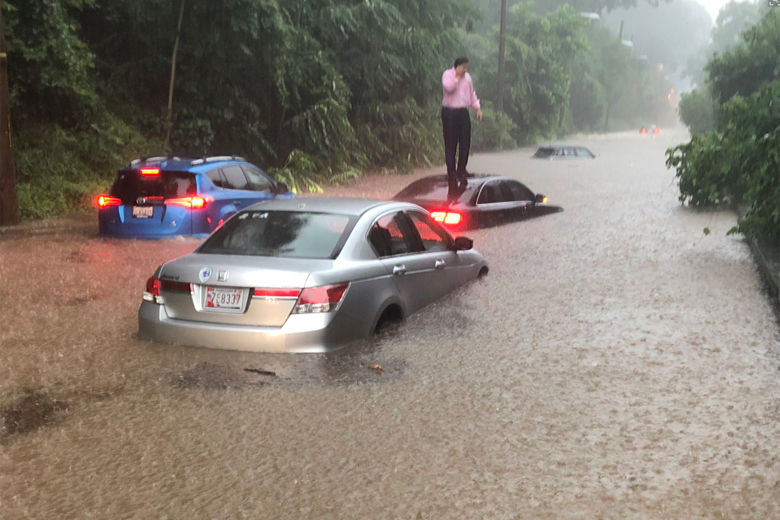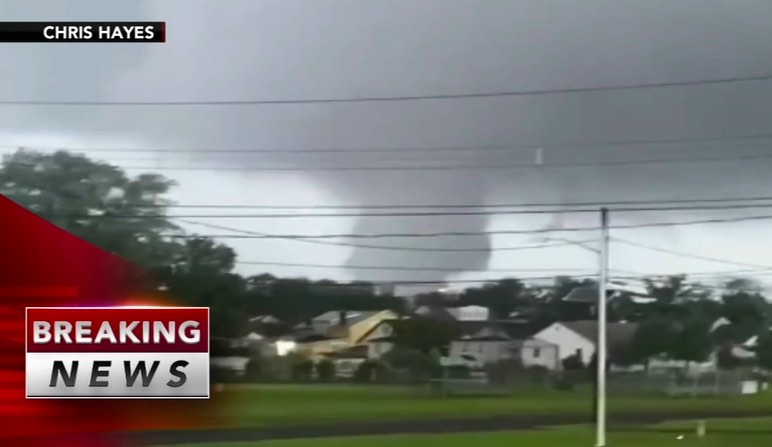Of one thing we can be certain: The WSJ troll Holman Jenkins Jr, is also no changeling - especially regarding climate change. In his latest propaganda effort ('The Media Can't Handle Climate Change', Sept. 4-5, p. A15) he reels off a dizzying array of canards, baloney and distractions, writing for example:
"If “news” is about how today differs from yesterday, the press missed a lot of news in the long-awaited new report from the United Nations Intergovernmental Panel on Climate Change that was issued a few weeks ago.
After 41 years of promoting a fuzzy and unsatisfying estimate of how much warming might result from a doubling of atmospheric CO2, the world’s climate science arbiter has finally offered the first real improvement in the history of modern climate science.
Through five previous U.N. assessments plus their predecessor, the 1979 Charney Report, the likely worst-case was a rise of 4.5 degrees Celsius. This came from averaging the result of inconsistent computer climate simulations about which the IPCC knew only one thing: They couldn’t all be right and perhaps none were."
Please. Try to get your act together, Holman. But instead he compounds his ignorance. It never occurs to this forlorn meathead that all could be right - but at different times. As per climate scientist Gunther Weller's models we expect a series of tipping points for which the control parameters (e.g. CO2 concentration) alter radically at every point. (Tipping points). Even Holman acknowledges this in his earlier (Aug. 11th) column, writing:
"The big risks in the IPCC report are the known unknowns, the possibility of sudden tipping points in ice sheets or ocean circulation."
So what's new? Well, nothing. Two key points are missed by Jenkins:
1) Tipping point transitions are governed by a potential V(x,c) with c the control parameter and described by a point x Î R n that minimizes the potential. Changing external conditions - say pumping out more CO2 into the atmosphere (say from all the megafires) - changes the values of the control parameter c and that in turn changes the shape of the potential V(x,c).
As the shape of the potential V(x,c) changes the original global minimum becomes metastable or even disappears. I believe we are at such a metastable point now with the concentration having jumped by > 5.1 ppm in just 2 years. The danger then is the global climate system being knocked into instability and assuming a new global minimum leading to a planet with even more hostile conditions. (In this case like the Pliocene era.)
2) The pre-existing CO2 burden only adds to (1). While about half of that carbon dioxide is currently absorbed by the world’s forests and oceans, the other half stays in the atmosphere, where it lingers for thousands of years, steadily warming the planet. Even if all CO2 emissions halted today it would not make a dent in the long term accumulations already in the atmosphere.
The process may be described something like a series with terms being added, viz: to describe the CO2 content now in the atmosphere, we must initiate the series with n= 1 (for 1921), viz.
CO2( 2021) = x 1 + x 2 + x 3 + x 4 +.............+ x 1 00
Terminating at the last term 100 years later. Here each ‘x’ denotes the CO2 burden added for each year in succession.
Thus, the CO2 effect for a given year is not just for that year, but rather inclusive of the cumulative additions for all the years - starting up to 100 years before.
This means things can only get worse, and no amount of carbon credits pricing or trading will save the day. Even more sobering, we've yet to experience the full effects of the CO2 we've already emitted, mostly because it takes the oceans a long time to warm in response to a given level of CO2 - and the oceans are the primary buffer mitigating the worst greenhouse warming effects right now
But Holman goes on scribbling:
"Using real-world data, the new report now says the worst case is a 4-degree rise."
Wrong! According to the report:
"Crossing the 2°C global warming level in the mid-term period (2041–2060) is very likely to occur under the very high GHG emissions scenario (SSP5-8.5), "
In that SSP5 -8.5 scenario we will see an increase of 5.7 C by 2100, which is the level expected by the Bulletin of the Atomic Scientists - which noted two years ago that IPCC climate report understated the threat. By logical extension, this current one also does. Do the math. If the current rate of CO2 concentration increase is at 2.5 W/ m2 the CO2 concentration is increasing at 2.5 ppm/ yr.
Then add 75 yrs. projected increase to the current mean yearly value of 415 ppm. In 75 years that means an additional (2.5 ppm/ yr. x 75 yrs.) = 187.5 ppm or 415 ppm + 187.5 ppm = 602.5 ppm. But most climate scientists - such as Prof. Gunther Weller- take 600 ppm as the threshold for the runaway greenhouse effect. In other words we would see the advent of an entirely new potential V(x,c) - with c > 600 ppm, and a catastrophic global equilibrium.
Climate blogger John Atcheson cited two reasons why this is also highly probable:
1) Most of the climate-related estimates you hear in the news and from the IPCC have built in assumptions that we humans will take necessary actions to mitigate the worst of the climate crisis. There’s no evidence that making such assumptions is a prudent thing to do. We’ve known about this unfolding tragedy for three decades now, yet we’ve been steadily increasing the amount of greenhouse gasses we release.
In other words human behavior is not going to change in the short term, any more than it has in the longer term. So one's best bet is to project the most dire SSP5-8.5 scenario on the temperature change- which means 5.7 to 7.0 C or effectively runaway greenhouse level. Again, conforming to the projected increase in CO2 concentration by 2100.
2) The second reason the climate crisis is likely far more dire than most people have been led to believe is that the IPCC, most of the scientific community, and the media present mid-range scenarios for temperature increases, not worst-case forecasts, and usually they don’t include potentially dangerous feedbacks.
More bollocks from Holman:
"More important, with much greater confidence than before, disastrous outcomes above 5 degrees are now found to be very unlikely. In another departure, the U.N. panel now says the dire emissions scenario it promoted for two decades should be regarded as highly unlikely, with more plausible projections at least a third lower.
But again, the projected increase in CO2 concentration doesn't square with this. You simply cannot have "outcomes" below the 5 degree level but CO2 concentrations > 600 ppm. Hence, the more plausible projection must always conform to the higher concentrations expected- also there is no chance of them getting lower, especially given the existing CO2 burden we are constantly adding to. And none of this takes into account the current added emissions of methane (CH4) - an even more potent greenhouse gas - as a result of melting permafrost in the Arctic.
Holman bloviating again:
"The report also notes, as the press never does, the full impact of these emissions won’t be manifested until decades, even a century, later."
What comic did you get that from, sonny? The onslaught we are now seeing worldwide with massive mega fires in Greece, Turkey, Amazonia, Indonesia, France, Canada and Australia. Siberia and California, 1,000 year floods in Germany, the U.S. and China, and mega droughts here in the U.S. West, is but a meager prelude to what we will experience by 2100, and even before. Again, the added energy release tracks with the CO2 concentration increase.
But why stop there when Holman is on a roll with his canards and codswallop:
"The ultimate likely worst-case effect of a doubling of CO2 might be 4 degrees, but the best estimate of the “transient climate response” this century is about 2.7 degrees, or 1.6 degrees on top of the warming experienced since the start of the industrial age."
Again, what sci-fi comic did you get that from? As I showed, given the level of increase in CO2 concentration expected - past 600 ppm by 2100 - we will surely be at the threshold of the runaway greenhouse effect and that implies a temperature increase of 6C or 10.8 F. This according to Carl Sagan- warning of a temperature change up to 11 F- in his essay 'Ambush- The Warming of the World' in his book, 'Billions & Billions'.
Again, where does Jenkins come up with this lowball malarkey? Not from properly assessing the report. Adding:
"You might not wish this on your least-favorite planet, but compare it with media coverage of the U.S. National Climate Assessment in 2018, which paraded as a nearly foregone conclusion a temperature increase of 6.1 degrees."
That's actually closer to the true expected increase, as I showed. Can Holman do some math? Evidently not. Maybe then he at least needs to read Sagan's chapter just cited, before he next sounds off.
But Jenkins Jr. isn't done:
By now, though, the press and the climate science impresarios know each other too well, thus scripted idiocies abound. This week’s massive rainstorm in the Northeast reflexively was described as a consequence of climate change. Never mind that heavy rains always happened and, in any case, climate policy can’t be a solution for a New York City storm-drain system designed not to withstand a five-year storm, let alone a 100-year storm.
What about the massive floods we've just seen in Germany and China? Do those "always happen"? If Holman would pull his head out of his ass enough to see daylight one might get it through his thick noggin that a warmer atmosphere holds much more moisture and it then takes only a trigger to unleash it. As for "scripted idiocies" the only ones I've seen are emanating from Holman Jenkins Jr. - at least on climate (and Covid.) As when he scribbles:
"Or take the U.S. government’s claim that July was the hottest month on record. Unmentioned in any news report that I could find, the margin of error in this measurement was 10 times as large as the purported difference over the previously claimed hottest month of July 2016."
Here it's clear Jenkins definitely needs to read Sagan's chapter and how temps. and their associated errors get quantified. Especially in relation to a prior year or era. In this case we now know July, 2021 was 0.93 C above the 20th century average of 15.8 C. That is 0.01 C of a degree higher than the July, 2016 record. So what's Holman's beef? Well, he's peeved because the variance is some 10 times greater than the difference or 0.1C. But he's not acknowledging the input of some 6,300 meteorological stations to obtain the difference of 0.01C, for which that variance is more than acceptable. One is led to rightly ask here if he's ever taken a statistics course.
Predictably he ends with the typical Holman Howler:
"Our climate fluctuates under many influences, but one factor that overwhelms all others is the increase in human beings and their valuable property placed in the path of extreme weather, behavior encouraged by politicians. "

by Dave Lindorff | September 6, 2021 - 5:50am | permalink


No comments:
Post a Comment